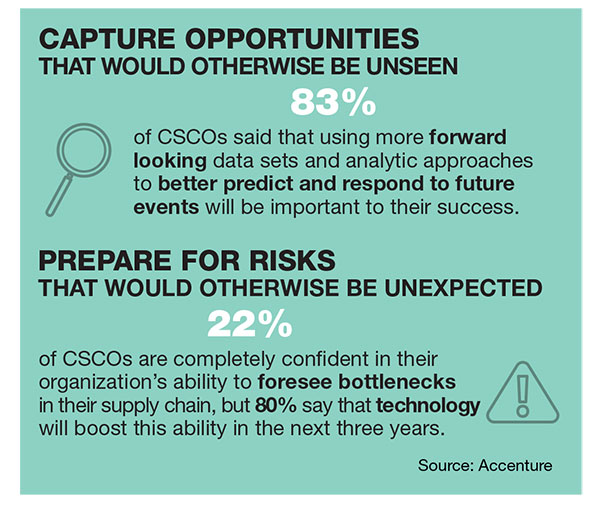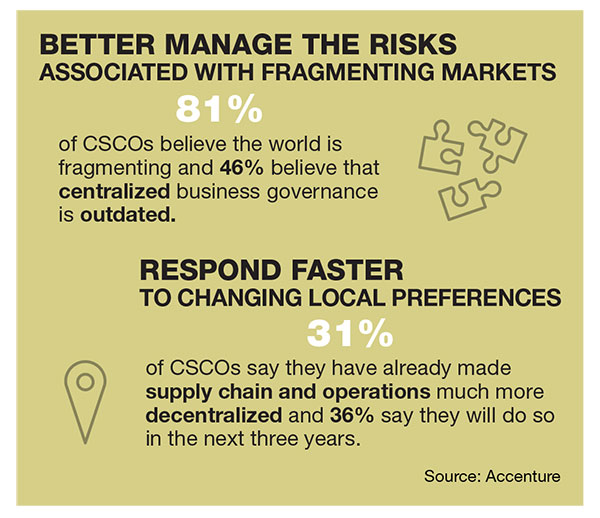Accenture on Operations: Why supply chain innovation paves the road to resilience
Supply chain executives should reflect on past challenges to identify potential areas of weakness and continue innovating for the future, with a resilient supply chain top of mind.
Nineteen months after the onset of the pandemic, organizations are still navigating strenuous supply chain challenges that ramped up when outbreaks first began—from asset capacity, labor, drivers, materials and inventory shortages.
Supply chain shortcomings were exposed this past year and a half, and it has become clear that many operations were woefully underprepared and lacking the necessary resilience and agility to deal with and counteract this unprecedented event.
Resilience—a company’s ability to absorb, adapt and recover from a disaster or catastrophic event—is one of the biggest areas of both concern and opportunity for chief supply chain officers (CSCOs). In fact, according to Accenture’s recent Business Futures report, companies are increasingly prioritizing restructuring their supply chains and approaches to production to counteract disruptions like these.
Now, leaders must learn and work to engineer more durable and efficient supply chains by focusing on digital transformation, managing risk and training their people for their organizations to become future-proof.
Investing in digital transformation
Digital transformation—like utilizing real-time, predictive analytics, sourcing from artificial intelligence (AI) and machine learning (ML) and leveraging the Cloud—is at the heart of supply chain resilience. It’s encouraging that capturing value from emerging, disruptive technologies continues to gain traction across the board. In fact, Gartner has reported that 87% of supply chain professionals plan to invest in resilience in the next two years.
Because one single application can’t improve resilience on its own, supply chain executives keenly understand that connecting and harnessing multiple technologies can best meet end-to-end supply needs, unlock potential and help organizations not only respond, but also recover and reset quickly.
These realizations are becoming more mainstream; while less than a quarter (22%) of CSCOs are currently “completely confident” in their ability to anticipate disruptions in their supply chains, 80% believe that technology will improve capabilities in the next three years, according to Accenture’s Business Futures research.
The Cloud provides a foundation for unrestricted access to technologies that might normally be out of a company’s reach, creating a ripe environment for innovation. It’s no surprise then that, according to Accenture research, 93% of supply chain executives expect 50% or more of their business to be in the Cloud in the next three years.
A more integrated Cloud infrastructure—paired with built out data analytics—can provide a roadmap for organizations looking to inform better decision-making and adapt to unfamiliar and unforeseen situations across various business functions.

Managing risk and stress testing supply chains
In addition to helping companies adapt more quickly, a resilient supply chain can also deliver lower overall risk, improve security to keep people and products safe and secure, and increase transparency for all customers along the value chain—all while optimizing costs in real time across the entire supply network.
Companies that have been affected by a major event can quickly reset and continue to serve customers with little to no material effect to their top and bottom lines. In some cases, organizations can even drive growth by outperforming their peers. Companies across industries have demonstrated capabilities to pivot, flex and reset their respective networks to ensure supply could flow to where it was needed after the pandemic hit, even when customers’ needs dynamically changed.
Because supply chains are always susceptible to change, organizations can look to stress tests to periodically identify areas of potential vulnerability. Accenture and the Massachusetts Institute of Technology (MIT) developed a supply chain resilience stress test that assesses operational and financial risk specifically.
This approach—which was inspired by the financial services stress tests that became compulsory after the 2008 financial crisis—can help organizations quickly identify potential points of supply chain failure, assess their related financial exposure, define appropriate mitigation strategies and actions, and benchmark resilience against their peers.
Throughout the stress test process, executives should thoughtfully consider how to navigate the balance between risks and costs so they can more effectively apply the learnings of these routine exercises to future decision-making. Ultimately, organizations can create real value for key stakeholders when supply chain resources help shift risk managers’ focuses from defense to offense.
A holistic, people-centric approach
Organizations must adopt a holistic operating model to evaluate how the business services its people and customers, while simultaneously leaning on key resources, such as technology, governance, and analytics. Because the focus is often squarely on technology when it comes to capability improvements and building resilience, optimizing the potential of the workforce is one of the most overlooked areas for organizations.

It’s no surprise that the journey to achieving a more resilient supply chain can be overwhelming given the many new and emerging technologies—and knowing where to start improving a company’s ability to adapt to real time events is challenging. However, organizations must understand the root cause of the issues within their supply chain to effectively diagnose and prescribe the right mix of people, process and technical changes to improve overall resilience.
While investing in technology is expected to dramatically enhance companies’ levels of resilience, resiliency can only be truly realized when organizations also upskill their people and foster cultures of continuous learning.
As a result, an upskilled workforce can better manage and communicate with the new technology, improving abilities to resolve issues more quickly and efficiently. This all starts with prioritizing supply chain design.
Supply chain executives should reflect on past challenges to identify potential areas of weakness and continue innovating for the future, with a resilient supply chain top of mind. It’s evident that adopting necessary technologies to activate an organization’s proper channels and increase connectivity and communication throughout the supply chain can pay off in the long run.

Article Topics
Motor Freight News & Resources
LM Podcast Series: Assessing the freight transportation and logistics markets with Tom Nightingale, AFS Logistics XPO opens up three new services acquired through auction of Yellow’s properties and assets FTR’s Trucking Conditions Index weakens, due to fuel price gains TD Cowen/AFS Freight presents mixed readings for parcel, LTL, and truckload revenues and rates Preliminary March North America Class 8 net orders see declines National diesel average heads down for first time in three weeks, reports EIA Trucking industry balks at new Biden administration rule on electric trucks: ‘Entirely unachievable’ More Motor FreightLatest in Logistics
LM Podcast Series: Assessing the freight transportation and logistics markets with Tom Nightingale, AFS Logistics Investor expectations continue to influence supply chain decision-making The Next Big Steps in Supply Chain Digitalization Warehouse/DC Automation & Technology: Time to gain a competitive advantage The Ultimate WMS Checklist: Find the Perfect Fit Under-21 driver pilot program a bust with fleets as FMCSA seeks changes Diesel back over $4 a gallon; Mideast tensions, other worries cited More LogisticsSubscribe to Logistics Management Magazine

Find out what the world's most innovative companies are doing to improve productivity in their plants and distribution centers.
Start your FREE subscription today.
April 2023 Logistics Management

Latest Resources
















